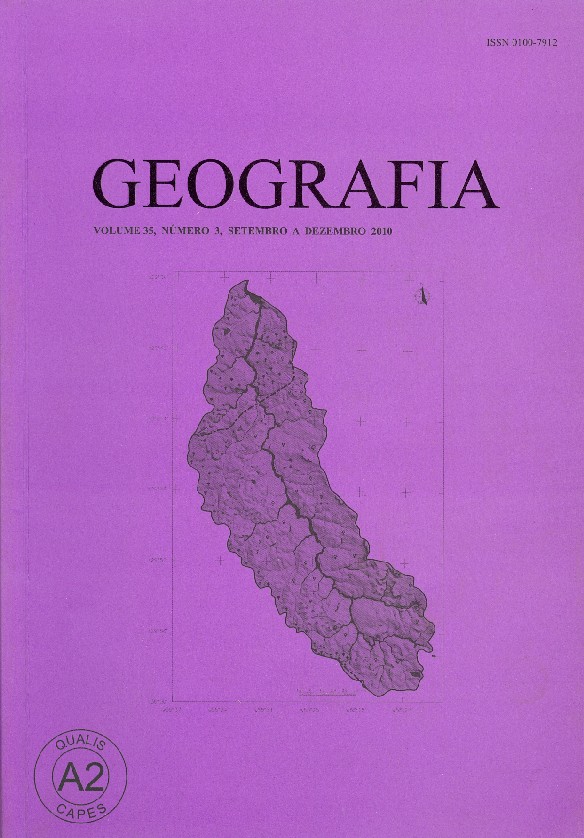COMPLEXIDADE DAS PAISAGENS DO PROJETO DE ASSENTAMENTO BENFICA, SUDESTE PARAENSE, ESTADO DO PARÁ
Abstract
Este trabalho tem como principal objetivo analisar e espacializar a evolução dos estados de transformação da complexidade, de diferentes Tipos de Paisagens do Projeto de Assentamento Benfica, Mesorregião Sudeste Paraense. Foram utilizadas imagens de satélite Landsat-TM correspondentes a 1987, 1992, 1996, 2001 e 2005 e técnicas de Geoprocessamento conduzidas no sistema SPRING, além de dados de campo e modelos gráficos da paisagem. A metodologia aplicada permitiu a identificação, classificação e quantificação de seis Tipos de Paisagens: Florestal (TP0), Mosaico Agrícola (TP1), Mosaico Agrícola com Pastagem (TP2), Grandes Extensões de Pastagem (TP3), Grandes Extensões de Pasto com Babaçu (TP4) e Babaçual (TP5). A integração dos resultados deu origem a uma Escala de Complexidade dos Tipos de Paisagens, em que os graus de intensidade variaram do mais “simples” (0) ao mais “complexo” (12), sendo os de maior intensidade os Tipos de Paisagens Florestal (TP0), Mosaico Agrícola (TP1) e Mosaico Agrícola com pastagem (TP2). A abordagem geográfica refletiiu diferentes dinâmicas que se estabelecem a partir das condições e chances de manter ou não os sistemas produtivos, fazendo aumentar ou diminuir o seu grau de complexidade. O enfoque na complexidade de uma tipologia de paisagens permitiu tratar questões ligadas à sua dinâmica e mostrou ser aplicável para qualquer planejamento ou estratégia de conservação ambiental. Palavras-chave: Sudeste Paraense. Projeto de assentamento. Tipos de paisagens. Complexidade da paisagem. Complexity of settlement project landscapes in Benfica, southeastern of Pará, State Pará This work has as main objective to analyze and spot the evolution of complexity conversion of different types of landscapes in Benfica Settlement Project, southeastern region of Pará. We used images from Landsat-TM corresponding to 1987, 1992, 1996, 2001 and 2005 and geo processing techniques conducted by SPRING system, as well as field data and graphical models of landscape. Applied methodology allowed the identification, classification and quantification of six types of landscapes: Forest (TP0), Agricultural Mosaic (TP1), Mosaic of Agricultural Pasture (TP2), large areas of pasture (TP3), large areas of pasture with Babassu ( TP4) and forest of Babassu palms (TP5). Integration of results led to a range of complexity of the types of landscapes, where the degrees of intensity ranging from “simple” (0) to more “complex” (12), being the more intense the Types of Forest Landscapes (TP0), agricultural Mosaic (TP1) and Mosaic Agricultural pasture (TP2). The geographical approach reflected different dynamics that are established based on the conditions and chances of maintaining or not the production systems, thus increasing or decreasing its complexity. The focus on the complexity of a typology of landscapes allowed addressing issues related to their function and proved to be applicable to any plan or strategy for environmental conservation. Key words: Southeast of Pará. Settlement project. Types of landscapes. Complexity of the landscape.Downloads
Published
Issue
Section
License
The authors maintain the copyright and grant GEOGRAFIA the right of first publication, with the articles simultaneously licensed under the Creative Commons BY 4.0 License, which allows sharing and adapting the articles for any purpose, as long as appropriate credits and provisions of image rights, privacy or moral rights. Other legal attributions can be accessed at: https://creativecommons.org/licenses/by/4.0/legalcode.en.
Geography, Rio Claro, SP, Brazil - eISSN 1983-8700 is licensed under the Creative Commons BY 4.0 License.





